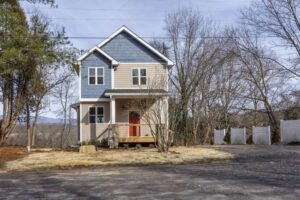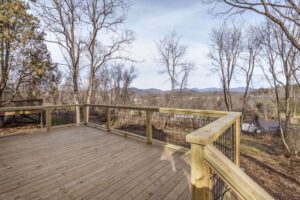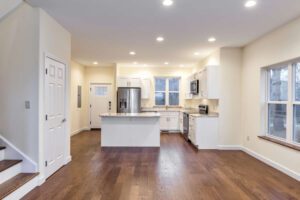The first time my wife Maureen and I looked at this overgrown 4-acre property in the Oakley neighborhood in the city of Asheville, I held our 3-year-old daughter in my arms to protect her from the large, lonely mare that was literally running free.
Piles of manure on the narrow, dead-end road surely disturbed the neighbors who parked there. The 1932 ranch house was significantly fire-damaged, and the single-wide next door could have been condemned. The two junked cars in the makeshift garage, the electrical service cut at the masthead by the power company, and the squatter with a sordid history rounded out the picture. They say he won the place in a card game, that someone died there, that the fire was suspicious.
Regardless, the house was in foreclosure and needed a ton of work, and Maureen recalls me saying, “Over my dead body.”
After searching for months more, we bought the place, and replaced the trailer with a new double-wide (grandfathered in), where we lived while we renovated the house over several months. We put in all new heating, electrical, and plumbing systems, as well as good new windows and doors, leaving only the roof and the original oak floor, which refinished nicely.
We spent $60,000 to fix up the house and, with new insulation where there was none, our home performed the same or better than the most efficient home of its type. The new propane furnace broke down after 25 years, so we replaced it with a high-efficiency electric heat pump, which Maureen supplements with electric space heaters as she needs.
The house continues to be most efficient. We raised two children and several dogs and cats here, and we remain here today. The daughter I mentioned is now 35 and our son is 30. We’ve been here a while — you can do the math.

New Urbanism
We were both drawn to the Traditional Neighborhood Development, now known as New Urbanism, encouraging social connection among neighbors, often in mixed-use environments.
Located a mile from Biltmore Village, density on this land was most appropriate. We wanted to build cottage development — small, close-in homes around a common space, with designated parking away from the homes. Sadly, we were unable to accommodate a cottage development on the steep land.
After renting it out for years, we finally moved the double-wide off the land and built and bonded a road out front. We completed and sold the first 3-bedroom, 2.5-bath, 1,484-square-foot home at the end of 2018, which was certified through Green Built Homes and ENERGY STAR® with a Home Energy Rating System (HERS) Score of 79.
Since then, through the pandemic and all, an 18-home development was designed complete with new road, street trees and lighting, stormwater retention system, and common land where there’s a small stream. A licensed utility contractor completed most of the phase one infrastructure (road, sewer, water) and we bonded the rest with the city of Asheville.
We recently got property identification numbers for the first two lots, and I just received the building permit for the next home, also a 3-bedroom, 2.5-bath.
All along, it’s been one darn delay after another, trying our patience, and while I’m sure that will continue, it’s a great relief to finally get building. We are certainly grateful to make our dream a reality.

Project Priorities
With the evaluation of an energy rater, all the homes will be certified through Green Built Homes and ENERGY STAR® to maximize comfort, efficiency, and indoor air quality. A geezer like me can always benefit from updated “building science” — barely a term when I apprenticed in the early 1970s, when heating oil was about 36 cents a gallon ($1.61 adjusted for inflation), astronomically less than the current $5.14 a gallon.
I have chosen two different stock plans from an architect, who altered them slightly at my request, including adding floor trusses for plumbing and ductwork, and 2-foot-by-6-foot exterior walls for insulation. Most, if not all, of this architect’s plans have only four foundation corners and some interior piers, and they use material efficiently.
Thanks to my rater’s advice, it was surprisingly simple to build my first Green Built Homes and ENERGY STAR®-certified home, after building four new homes and numerous substantial additions over my nearly 50-year career.
The first home we built here is on a sealed, conditioned crawl space with a dehumidifier whose condensate is piped to the outside. The next several homes are on steeper slopes, and will have roughed-in, unfinished daylight basements with a utility room. All are solar ready.

Both density and green certification were among our priorities, as was affordability. I initially wanted at least 20 percent of the homes to be affordable by HUD standards, with a mortgage no more than 30 percent of 80 percent of the local median household income of about $53,600. This would translate to a payment of $1,072 per month not including taxes and insurance, meaning a new home sale price of $235,000.
Sadly, I can’t build, much less sell, the house for that today. While I built the first home for about $150 per square foot and sold it for about $250 per square foot, I expect the next one to cost $200 or more per square foot and sell for more than $300 per square foot.
Our long-term goal remains providing more affordable houses, which may come to pass before we’re done. We’re just rolling with the dramatic changes in the Asheville real estate market over the last few years. Currently, the American dream of home ownership is simply not attainable for many folks.
Throughout this project we have used some of our own funds and also OPM, or other people’s money. For the infrastructure and the first home, we borrowed from a beloved client and friend, and gave her a healthy return when we sold the home for full asking price after a week on the market. Currently, we have borrowed from two friends at a reasonable APR. We also have a substantial Home Equity Line of Credit with our mortgage lender.
Fortunately, the housing market here looks like a solid investment, at least for now. We hope and expect that after these first two, the new homes will begin pre-selling, so we can continue to use OPM as the buyers get a convertible construction loan.
Stuart is a husband and father, as well as a dog guardian, who walks in the woods every day, thus remaining relatively sane. A licensed general contractor and owner of Building for Life, he is impassioned by affordable, green housing, and lives in Asheville. He is a minimalist in most regards. Connect with Stuart at BuildingForLifeAsheville.com.
Project Team:
Builder — Building for Life
HERS Rater — Vandemusser Design
Site Design — Advantage Civil Engineering
Licensed Utility Contractor — Chonzie Inc.
Home Plans — Rick Thompson Plans
Foundation — Tinajero Masonry
Painting — Padilla’s Painting
Roofing — Century Contractors
Realtor — Asha Hertel with Town and Mountain Realty
Lender — State Employees Credit Union
You can also view this article as it was originally published on page 20 of the 2022-23 edition of the directory.

